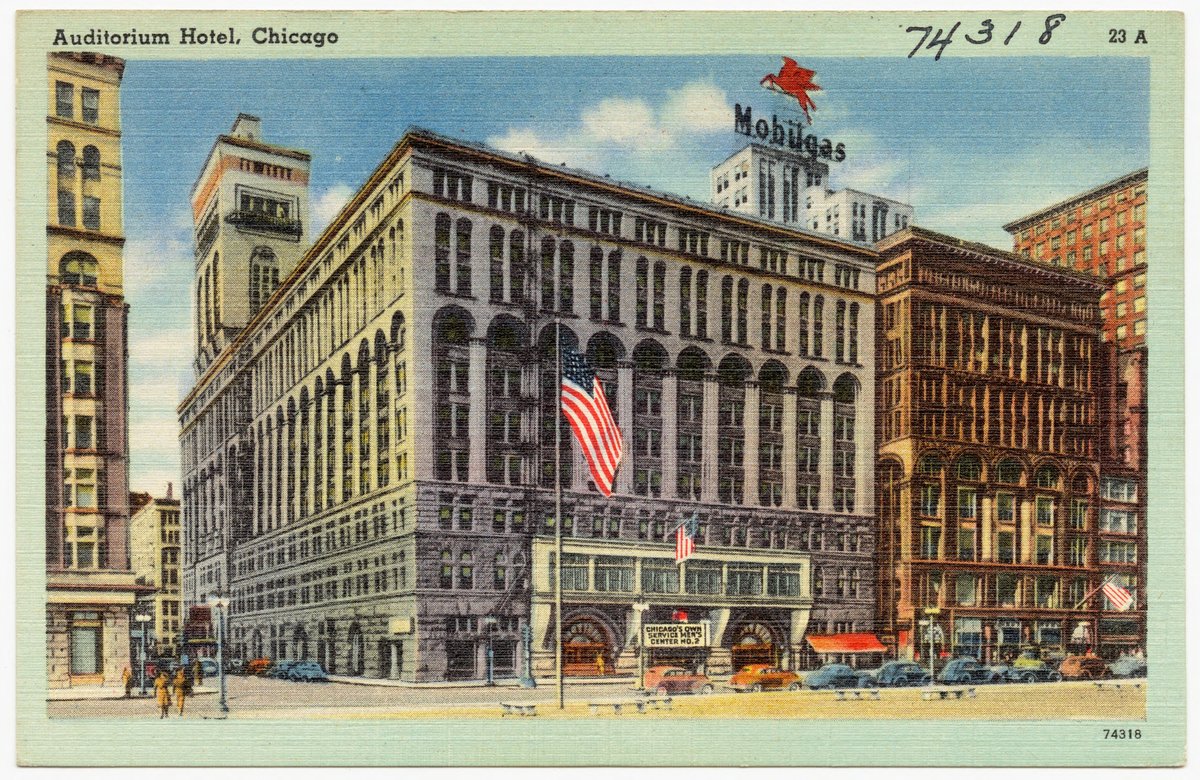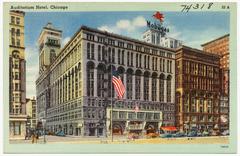
Fine Arts Building Chicago: Visiting Hours, Tickets, and Historical Sites Guide
Date: 15/06/2025
Introduction
Nestled at 410 South Michigan Avenue in downtown Chicago, the Fine Arts Building is a celebrated icon of the city’s artistic, cultural, and architectural heritage. Since its transformation from the Studebaker carriage showroom in 1898, the building has served as a dynamic vertical arts colony and creative hub for over 125 years, making it a must-visit for art lovers, architecture enthusiasts, and curious travelers alike (Encyclopedia of Chicago; Chicago Architecture Center).
This comprehensive guide covers the Fine Arts Building’s fascinating history, architectural significance, visiting hours, ticketing policies, accessibility, guided tours, and nearby attractions. You’ll also find practical travel tips, answers to frequently asked questions, and recommendations for making the most of your visit to one of Chicago’s most enduring cultural landmarks.
Table of Contents
- Historical Overview: Origins and Development
- Architectural Significance and Features
- Notable Tenants and Cultural Impact
- Visiting Information
- Artistic and Cultural Offerings
- Community Programs and Events
- FAQs
- Preservation and Legacy
- Final Travel Tips and Summary
- References
Historical Overview: Origins and Development
The Fine Arts Building was originally constructed in 1885 as the Studebaker Building, commissioned by the Studebaker Brothers for their carriage and automobile showroom and assembly facility. The structure, designed by renowned architect Solon S. Beman, embodied late 19th-century Chicago’s commercial ambition with its robust brick and terra cotta façade and large display windows.
In 1898, following the Studebakers’ relocation, the building underwent a transformative renovation. The upper floors were converted to studios, rehearsal spaces, and offices for artists and creative professionals. This shift marked the birth of one of America’s longest-running vertical arts colonies, supporting a thriving community of artists, writers, musicians, and performers for more than a century (Encyclopedia of Chicago; Chicago Architecture Center).
Architectural Significance and Features
The Fine Arts Building is a prime example of Richardsonian Romanesque architecture, with a façade featuring rusticated granite, limestone, decorative columns, and iconic oriel windows. Its ten-story height was notable for its time, and the 1898 renovation added artistic details such as hand-painted murals, custom woodwork, and mosaic tile floors. The Venetian Court, a skylit atrium introduced during the renovation, fills the building with natural light and serves as a gathering place for artists and visitors (Chicago Architecture Center).
Among the building’s most unique features are its original manually operated elevators—some of the last in Chicago—which offer visitors a living experience of early 20th-century urban life.
Notable Tenants and Cultural Impact
Over its storied history, the Fine Arts Building has hosted eminent artists, writers, and organizations that helped shape Chicago’s cultural legacy. Notable tenants have included:
- Frank Lloyd Wright (architect)
- Lorado Taft (sculptor)
- Harriet Monroe (founder of Poetry magazine)
- The Chicago Little Theatre
- The Chicago Women’s Club
- The Artists’ Guild
The building’s flagship Studebaker Theater, dedicated in 1898, has been a major venue for music, dance, theater, and public lectures, welcoming performers from Anna Pavlova to the Chicago Symphony Orchestra (yourchicagoguide.com; storiesfromthe78.com).
Today, the Fine Arts Building continues to support a diverse array of artists, organizations, and independent businesses, sustaining its role as a creative ecosystem at the heart of Chicago’s Loop.
Visiting Information
Hours and Entry
- General Building Hours: Monday–Saturday, 7:00 AM–10:00 PM; Sunday, 9:00 AM–10:00 PM
- Individual Studios/Galleries: Hours may vary by tenant. Check the official building website or contact specific tenants for details.
- Studebaker Theater: Hours depend on scheduled performances and events.
Entry: Public access to corridors, galleries, and some studios is free. Ticketed events may require advance purchase.
Tickets and Special Events
- General Admission: Free to public spaces and most galleries.
- Performances & Special Exhibitions: Tickets required; purchase online or at the box office.
- Second Fridays: Monthly open studios event (5:00–9:00 PM, second Friday of each month). Free and open to the public.
For ticketed events, visit the Fine Arts Building events page or the Studebaker Theater site for availability and pricing.
Directions and Accessibility
- Address: 410 S. Michigan Avenue, Chicago, IL 60605
- Public Transit: CTA Red, Blue, and Brown lines (Harold Washington Library-State/Van Buren station nearby); multiple bus routes on Michigan Avenue.
- Parking: Several nearby garages; public transit recommended due to Loop congestion (Time Out Chicago).
- Accessibility: Wheelchair accessible entrances, elevators to all floors, accessible restrooms, and service animals permitted.
Visitor Tips
- Wear comfortable shoes; exploring the building often involves multiple floors and long corridors.
- Photography is allowed in public areas, but please ask before photographing studios or during performances.
- Check the event calendar before visiting to catch open studios, performances, or special exhibitions (Fine Arts Building Events).
- Dining: Numerous cafes and restaurants are within walking distance on Michigan Avenue and in the South Loop.
Nearby Attractions
- Art Institute of Chicago
- Millennium Park
- Grant Park
- Auditorium Theatre
- Chicago Cultural Center
- Museum of Contemporary Photography
Take advantage of the building’s central location by pairing your visit with these world-class Chicago attractions.
Artistic and Cultural Offerings
Resident Artists, Studios, and Shops
The Fine Arts Building is home to over 80 tenants, including renowned violin dealers (Bein & Fushi), music retailers (Performers Music), independent bookstores (Exile in Bookville), visual artists, dance studios, and music schools. Many studios welcome visitors during open house events, offering opportunities to see art-making in progress, purchase original works, or commission custom pieces.
Performance Venues
- Studebaker Theater: A beautifully restored, 740-seat theater hosting concerts, theater, and dance. Known for its ornate design and excellent acoustics.
- Carriage Hall: An intimate venue for chamber music, literary readings, and experimental performances.
Galleries and Exhibitions
Multiple galleries within the building showcase rotating exhibitions by resident and guest artists. Admission is typically free, and exhibitions change regularly.
Community Programs and Events
- Second Fridays: Monthly open studio nights (second Friday, 5:00–9:00 PM).
- Annual Open Studios Weekend: A fall event featuring building-wide access, demonstrations, and interactive activities.
- Workshops, Lectures, and Readings: Ongoing programs that invite public participation and engagement with Chicago’s creative community.
Details and schedules are available on the Fine Arts Building’s events page.
FAQs
Q: What are the Fine Arts Building’s visiting hours?
A: Generally Monday–Saturday, 7:00 AM–10:00 PM; Sunday, 9:00 AM–10:00 PM. Individual studios and venues may have different hours.
Q: Is there an entrance fee?
A: Entry to public spaces and galleries is free. Some performances, workshops, or special exhibitions require tickets.
Q: Is the Fine Arts Building wheelchair accessible?
A: Yes, with elevators, accessible entrances, and restrooms. Service animals are permitted.
Q: Are guided tours available?
A: Yes, through the Chicago Architecture Center and during special events. Check the tours page for details.
Q: Can I take photographs inside?
A: Photography is generally allowed in public areas and galleries; please request permission before photographing inside studios or during performances.
Preservation and Legacy
The Fine Arts Building is listed on the National Register of Historic Places and is a designated Chicago Landmark, ensuring the preservation of its unique architectural features and artistic legacy (Choose Chicago). Ongoing restoration efforts maintain its hand-painted murals, woodwork, and historic performance spaces, enabling the building to serve both as a living museum and a creative incubator for new generations.
Final Travel Tips and Summary
- Plan ahead: Check the building’s website for current hours, event listings, and guided tour availability.
- Wear comfortable shoes for exploring multiple floors.
- Engage with artists: Many tenants welcome conversation and questions about their work.
- Combine your visit with other nearby attractions for a full day of cultural exploration.
- Support local artists by purchasing art, books, or music from building tenants.
The Fine Arts Building is a living monument to Chicago’s artistic and architectural history, providing an immersive, authentic experience for every visitor. Whether you’re attending a performance, exploring open studios, or simply admiring the Venetian Court, your visit will connect you to over a century of creative achievement in the heart of Chicago.
For the latest information, visit the official Fine Arts Building website and download the Audiala app for curated guides, updates, and insider tips on Chicago’s cultural landmarks.
References
- Encyclopedia of Chicago
- Chicago Architecture Center
- Choose Chicago: 10 Iconic Buildings in Downtown Chicago
- Your Chicago Guide
- Stories from the 78
- Fine Arts Building Official Website
- Choose Chicago: Open Art Gallery Studio Nights
- Time Out Chicago – Travel Tips
- Travel Pug – 19 Historical Spots in Chicago
- Lonely Planet – Things to Know Before Traveling to Chicago





























































































































































